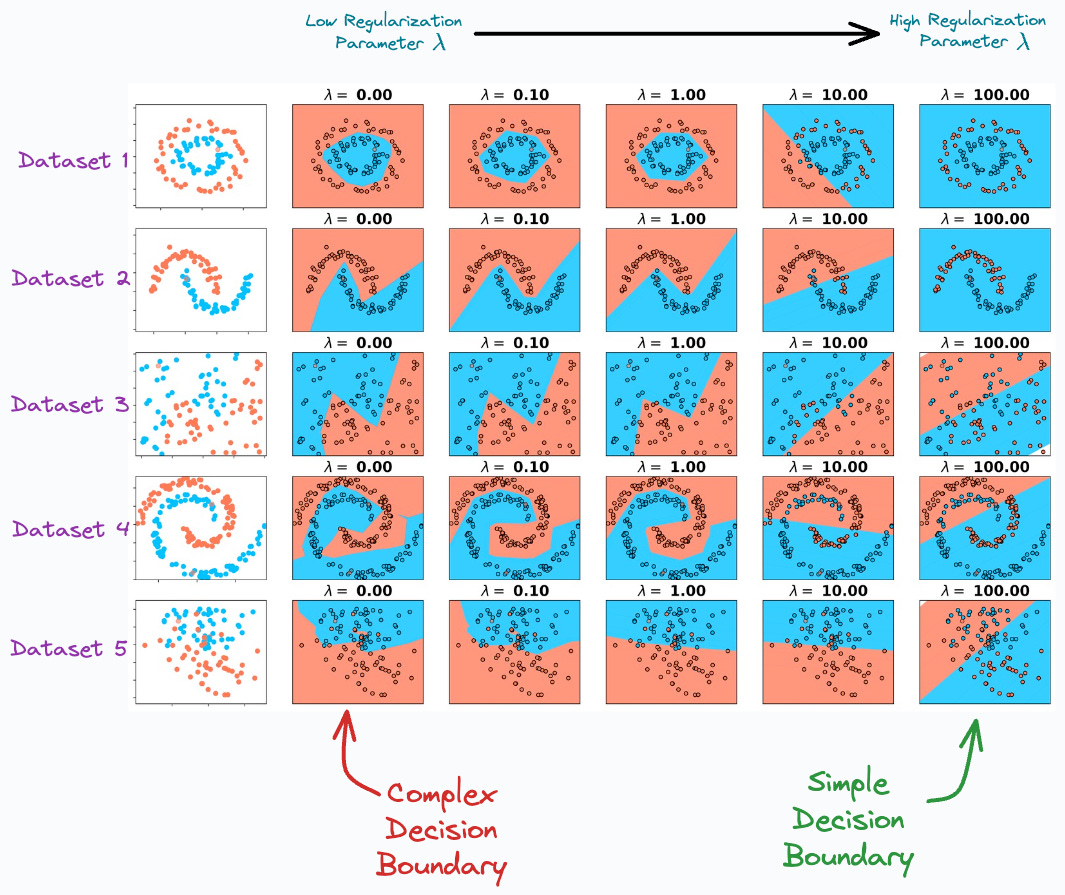L2 Regularization is Much More Magical That Most People Think
An untaught advantage of L2 regularization that most data scientists don't know.
Almost every tutorial/course/blog mentioning L2 regularization I have seen talks about just one thing:
L2 regularization is a machine learning technique that avoids overfitting by introducing a penalty term into the model’s loss function based on the squares of the model’s parameters.
In classification tasks, for instance, increasing the effect of regularization will produce simpler decision boundaries.
Of course, the above statements are indeed correct, and I am not denying that.
In fact, we can also verify this from the diagram below:
In the image above, as we move to the right, the regularization parameter increases, and the model creates a simpler decision boundary on all 5 datasets.
Coming back to the topic…
However, what disappoints me the most is that most resources don’t point out that L2 regularization is a great remedy for multicollinearity.
Multicollinearity arises when two (or more) features are highly correlated OR two (or more) features can predict another feature:
When we use L2 regularization in linear regression, the algorithm is also called Ridge regression.
But how does L2 regularization eliminate multicollinearity?
Today, let me provide you a demonstrative intuition into this topic, which will also explain why “ridge regression” is called “ridge regression.”
Let’s begin!
Dummy dataset
For demonstration purposes, consider this dummy dataset of two features:
As shown above, we have intentionally made featureB highly correlated with featureA. This gives us a dummy dataset to work with.
Going ahead, we shall be ignoring any intercept term for simplicity.
Linear regression without L2 penalty
During regression modeling, the goal is to determine those specific parameters (θ₁, θ₂), which minimizes the residual sum of squares (RSS):
So how about we do the following:
We shall plot the RSS value for many different combinations of (θ₁, θ₂) parameters. This will create a 3D plot:
x-axis → θ₁
y-axis → θ₂
z-axis → RSS value
Next, we shall visually assess this plot to locate those specific parameters (θ₁, θ₂) that minimize the RSS value.
Let’s do this.
Without the L2 penalty, we get the following plot (it’s the same plot but viewed from different angles):
Did you notice something?
The 3D plot has a valley. There are multiple combinations of parameter values (θ₁, θ₂) for which RSS is minimum.
Thus, obtaining a single value for the parameters (θ₁, θ₂) that minimize the RSS is impossible.
Linear regression with L2 penalty
When using an L2 penalty, the goal is to minimize the following:
Creating the same plot again as we did above, we get the following:
Did you notice something different this time?
As depicted above, using L2 regularization removes the valley we saw earlier and provides a global minima to the RSS error.
Now, obtaining a single value for the parameters (θ₁, θ₂) that minimizes the RSS is possible.
Out of nowhere, L2 regularization helped us eliminate multicollinearity.
Why the name “ridge regression”?
In fact, this is where “ridge regression” also gets its name from — it eliminates the ridge in the likelihood function when the L2 penalty is used.
Of course, in the demonstrations we discussed earlier, we noticed a valley, not a ridge.
However, in that case, we were considering the residual sum of error — something which is minimized to obtain the optimal parameters.
Thus, the error function will obviously result in a valley.
If we were to use likelihood instead — something which is maximized, it would (somewhat) invert the graph upside down and result in a ridge instead:
Apparently, while naming the algorithm, the likelihood function was considered.
And that is why it was named “ridge regression.”
Pretty cool, right?
When I first learned about this some years back, I literally had no idea that such deep thought went into naming ridge regression.
Hope you learned something new today :)
If you want to learn about the probabilistic origin of L2 regularization, check out this article: The Probabilistic Origin of Regularization.
👉 Over to you: What are some other advantages of using L2 regularization?
👉 If you liked this post, don’t forget to leave a like ❤️. It helps more people discover this newsletter on Substack and tells me that you appreciate reading these daily insights.
The button is located towards the bottom of this email.
Thanks for reading!
Latest full articles
If you’re not a full subscriber, here’s what you missed recently:
Don’t Stop at Pandas and Sklearn! Get Started with Spark DataFrames and Big Data ML using PySpark.
DBSCAN++: The Faster and Scalable Alternative to DBSCAN Clustering
Federated Learning: A Critical Step Towards Privacy-Preserving Machine Learning
You Cannot Build Large Data Projects Until You Learn Data Version Control!
Sklearn Models are Not Deployment Friendly! Supercharge Them With Tensor Computations.
Use this decision tree to decide:
To receive all full articles and support the Daily Dose of Data Science, consider subscribing below:
👉 Tell the world what makes this newsletter special for you by leaving a review here :)
👉 If you love reading this newsletter, feel free to share it with friends!














Your the best. Appreciate what you do.
No doubt that contents are of high quality. But more than content I like look and feel of fonts you use and simple but effective info graphics. If you don't mind can you please tell which tool you use for info graphics.